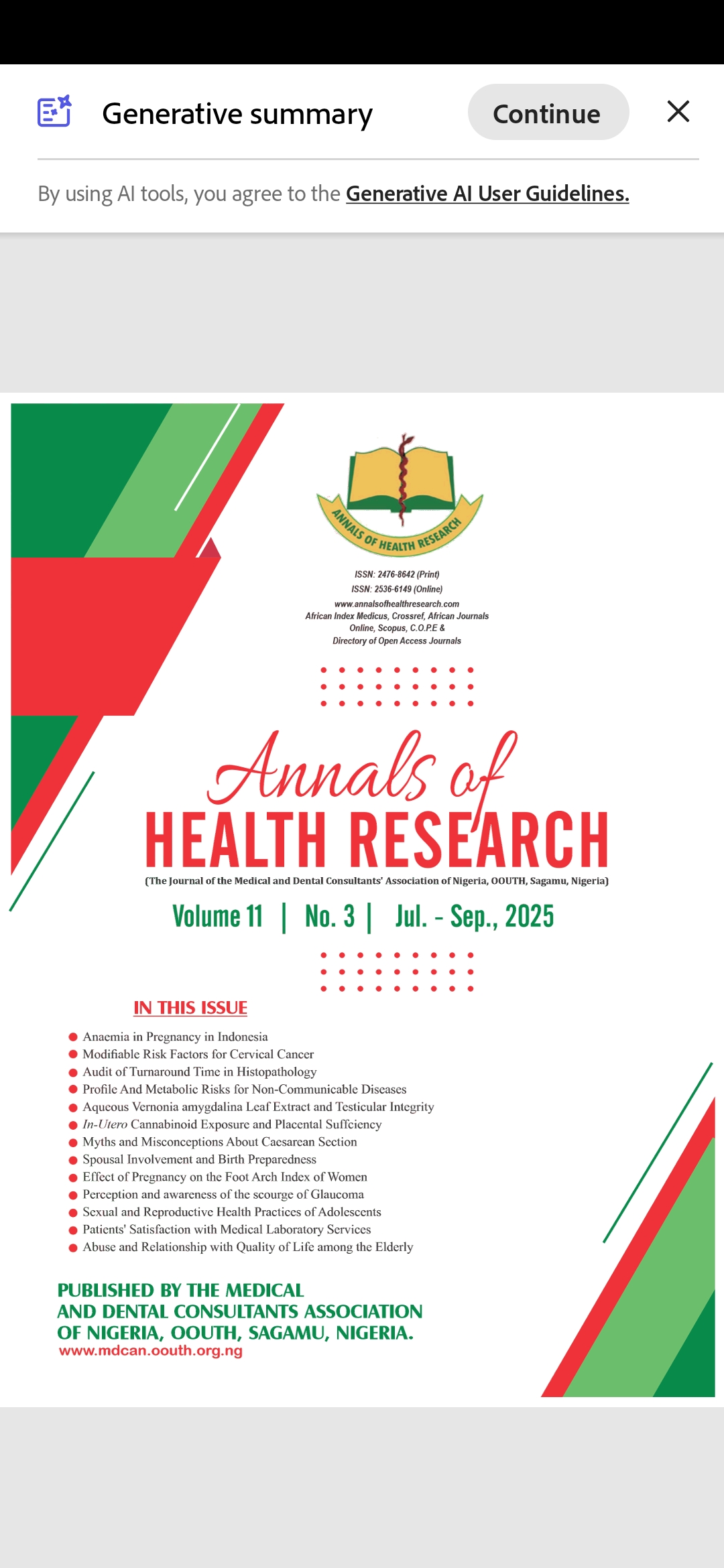A Cross-Sectional Study of the Effect of Pregnancy on the Foot Arch Index of Women
DOI:
https://doi.org/10.30442/ahr.1103-10-297Keywords:
Biomechanics, Flat Foot, Foot Arch Index, Foot Health, PregnancyAbstract
Background: Pregnancy induces some changes in the musculoskeletal system. Few studies have investigated these changes, especially their effects on foot structures.
Objective: To examine the effect of pregnancy on women's foot arch index and determine the relationship between the foot arch index (FAI), Body Mass Index, and the gestational age of pregnant women.
Methods: A cross-sectional examination of a sample of 118 pregnant, 101 nulliparous, and 101 non-pregnant women (who had been previously pregnant) was conducted. Footprints were obtained using the Ink and Plain Paper method, and foot arch indices were obtained from their footprints.
Results: The study revealed a statistically significant difference (p <0.001) in FAI between pregnant and non-pregnant women, with pregnant women exhibiting a higher average FAI. A positive linear correlation (r = 0.354, p < 0.001) was observed between BMI and FAI in pregnant women, indicating that higher BMI was associated with an increased FAI. Also, a statistically significant relationship between gestational age and FAI was observed among pregnant women (r = 0.231, p = 0.012). Altered FAI resulting from pregnancy persisted post-pregnancy. Age and weight were predictors of flat feet during pregnancy, whereas gestational age was not associated with the odds of flat feet.
Conclusion: Pregnancy induces significant changes in the foot arch. These changes persist beyond the pregnancy period. It is essential to monitor and address foot arch alterations during and after pregnancy, thus emphasising the need for appropriate interventions to mitigate potential discomfort and functional limitations in pregnant women and beyond.
References
1. Un-Chung C, Chih-Jung Y, Jing-Fu K, Ching-Lin H, Shun-Fa Y, Chun-Hou W. Footprint analysis of flatfoot in preschool-aged children. Eur J Pediatr 2011;170:611-617. https://doi.org/10.1007/s00431-010-1330-4.
2. Egwu OA, Okafor IJ, Ukoha U, Ogugua PC, Igwebuike JO, Igwenagu VU. Pes planus: Incidence among an adult population in Anambra State, southeast Nigeria. Int J Biomed Adv Res 2012;3: 166. https://doi.org/10.7439/ijbar.v3i3.286
3. Marianna TM, Bednarcikova L, Jozef Z. Effect of footwear to posture. Clin Technol 2020;50:58-64. https://doi.org/10.14311/CTJ.2020.2.03
4. Bird AR, Menz HB, Hyde CC. The effect of pregnancy on footprint parameters: a prospective investigation. J Am Podiatr Med Assoc 1999;89:405-409. https://doi.org/10.7547/87507315-89-8-405
5. Gabriel A, Gijion-Nogueron DPM, Gavilan-Diaz M, Valle-Funes V, Jimenez-Cebrian A, Cervera-Mavin, et al. Anthropometric foot changes during pregnancy. J Am Podiatr Med Assoc 2013;103:314–321. https://doi.org/https://doi.org/10.7547/1030314
6. Ugorji TN, Ibe IN, Nwakamma JI, Kekere TF, Bright-Ohaeri FC. Assessment of Plantar Arch Index and Prevalence of Pes Planus Among Adolescents: A Survey Study. Orthop Rheumatol Open Access J 2024; 23:556102. https://doi.org/10.19080/OROAJ.2024.23.556102
7. Dunn J, Habbu R, Bohay D, Anderson J. Effect of pregnancy and obesity on arch of foot. Orthoped Surg 2002;4(2):101-104. https://doi.org/10.1111/j.1757-7861.2012.00179.x
8. Segal NA, Boyer ER, Teran-Yengle P, Glass N, Hillstrom HJ, Yack HJ. Pregnancy Leads to Lasting Changes in Foot Structure. Am J Physical Med Rehab 2013;92:232. https://doi.org/10.1097/PHM.0b013e31827443a9
9. Gijon-Nogueron GA, Gavilan-Diaz M, Valle-Funes V, Jimenez-Cebrian AM, Cervera-Marín JA, Morales-Asencio JM. Anthropometric Foot Changes During Pregnancy. J Am Podiatr Med Assoc 2013;103:314-321. https://doi.org/10.7547/1030314
10. Cavanagh PR, Rodgers MM. The arch index: A useful measure from footprints. J Biomech 1987;20:547-551. https://doi.org/10.1016/00219290(87)90255-7
11. Queen RM, Mall NA, Hardaker M, Nunley JA. Describing the medial longitudinal arch using footprint indices and a clinical grading system. Foot Ankle Int 2007;28:456-462. https://doi.org/10.3113/FAI.2007.0456
12. Menz HB, Munteanu SE. Validity of 3 clinical techniques for the measurement of static foot posture in older people. J Orthop Sports Phys Therapy 2005;35:479-486. https://doi.org/10.2519/jospt.2005.35.8.479
13. Igbigbi PS, Msamati BC. The footprint ratio as a predictor of pes planus: A study of indigenous Malawians. J Foot Ankle Surg 2002;41:394-397. https://doi.org/10.1016/s1067-2516(02)80086-2.
14. Rössner S. Weight gain in pregnancy. J Human Reprod 1997;12:110-115. https://doi.org/10.1093/humrep/12.suppl_1.110
15. Mbada CE, Adebayo OE, Awotidebe TO. Practice and pattern of antenatal and postnatal exercise among Nigerian women: A cross-sectional study. Int J Women Health Reprod Sci 2015;3:93-98. https://doi.org/10.15296/ijwhr.2015.18
16. Ojukwu CP, Onwumere TH, Anekwu EM, Chukwu CS. Comparative study of the foot arch index among pregnant and non-pregnant women in a South-Eastern Nigeria community: A cross-sectional analysis. Crescent J Med Biol Sci 2016;3:81-85.
17. Dehghan F, Haerian BS, Muniandy S, Yusof A, Dragoo JL, Salleh N. The effect of relaxin on the musculoskeletal system. Scandinavian J Med Sci Sports 2014;24:e220-e229. DOI: 10.1111/sms.12149
18. Saugstad LF. Persistent pelvic pain and pelvic joint instability. Eur J Obstet Gynaecol Reprod Biol 1991;41:197-201. https://doi.org/10.1016/0028-2243(91)90024-f
19. Steinetz BG, Williams AJ, Lust G, Schwabe C, Bullesbach EE, Goldsmith LT. Transmission of relaxin and estrogens to suckling canine pups via milk and possible association with hip joint laxity. Am J Vet Res 2008;69:59-67. https://doi.org/10.2460/ajvr.69.1.59.
20. Dragoo JL, Castillo TN, Braun HJ, Ridley BA, Kennedy AC, Golish SR. Prospective correlation between serum relaxin concentration and anterior cruciate ligament tears among elite collegiate female athletes. Am J Sports Med 2011;39:2175-2180. https://doi.org/10.1177/0363546511413378.
21. Dragoo JL, Castillo TN, Korotkova TA, Kennedy AC, Kim HJ, Stewart DR. Trends in serum relaxin concentration among elite collegiate female athletes. Int J Women Health 2011;3:19-24. https://doi.org/10.2147/IJWH.S14188.
22. Qin X, Garibay-Tupas J, Chua PK, Cachola L, Bryant-Greenwood GD. An autocrine/paracrine role of human decidual relaxin. I. Interstitial collagenase (matrix metalloproteinase-1) and tissue plasminogen activator. Biol Reprod 1997;56:800-811. https://doi.org/10.1095/biolreprod56.4.800
Downloads
Published
Issue
Section
License
Copyright (c) 2025 Annals of Health Research (The Journal of the Medical and Dental Consultants Association of Nigeria, OOUTH, Sagamu, Nigeria)

This work is licensed under a Creative Commons Attribution-NonCommercial 4.0 International License.
The articles and other materials published in the Annals of Health Research are protected by the Nigerian Copyright laws. The journal owns the copyright over every article, scientific and intellectual materials published in it. However, the journal grants all authors, users and researchers access to the materials published in the journal with the permission to copy, use and distribute the materials contained therein only for academic, scientific and non-commercial purposes.


